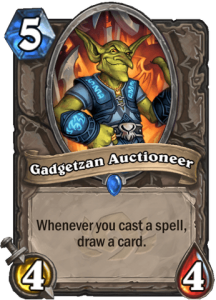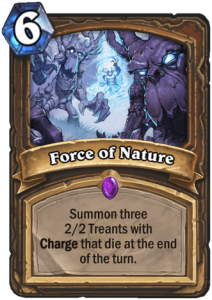As exciting as it is to play long gone archetypes again in Classic Mode, perhaps the most interesting question is whether we’ll discover brand new builds after all this time based on all the knowledge and the tools we’ve acquired since. Here are a few tenets we’ve figured out in the intervening years plus a set of first impressions in the new (well, old) mode.
Tempo Is the Most Valuable Resource
The attacker decides where the damage goes and the mana ramp is consistent. These core differences compared to a game like Magic the Gathering fundamentally change the relationship between tempo and value. Going fast and pressuring your opponent is the best way to find edges in Hearthstone, and every other strategy begins with a huge concession. Modern card design reflects this, with cheaper card draw and more readily available initiative tools (hello Rush keyword, goodbye Charge).
The complete lack of disruption options also makes it even more difficult to play a purely defensive playstyle. A Gadgetzan Auctioneer turn capped off with Conceal? You might as well click the button on the bottom right. How about Ice Block instead? No wonder almost every “control” archetype packs somewhere between 12 and 20 burst damage at least, and even Amaz’s fabled Control Priest had a random Mind Blast stashed in there somewhere to pulls some miraculous wins.
Card Advantage Is Not What It Used to Be
Play a quick (well, not really) game with Control Warrior against Midrange Druid and you’ll be surprised to see just how important it is to have one more card in your hand. One more option, a slightly more efficient removal, a bit more tempo and you might be able to push past their double combo setup. With Shield Block and Slam serving as little more than the redraw, you’ve only got the single Acolyte of Pain in the standard list to dig deeper.
With basically no card generation in Classic Mode, nor monstrous card draw cards like Skull of Gul'dan, the outcome of slower matchups really does depend on how efficient you can be with the resources at your disposal. You can’t just pull resources from thin air – you have to work hard to accumulate them and then spend them frugally. It remains to be seen whether we’ll see this aspect of the gameplay meaningfully explored again in the future of Hearthstone.
Burst Setups Need Consistency
Consider the previous two points, put them side by side and you may understand the pitfall we often fell into back in the day: with all the value and reliable chunky little midrange tools to add into the deck, do we really need to double down on an often redundant finisher?
Well, the answer is yes. Two copies of Force of Nature+ Savage Roar are better than one, and maybe even Handlock decks could use a bit of retooling with a greater emphasis on blowing up their opponent from hand. One Doomhammer for the one-cost Rockbiter Weapon? You might want to think again about that as well – you know, if you do end up picking Shaman at some point.
Most Neutrals Are Not Really Neutrals
Hearthstone’s hero powers and the wide pool of cards available to each class served as distinctive feature at the time of the game’s release. Though the neutrals served as a great way to introduce the collectible gameplay experience and make the F2P life a whole lot more palatable, the years since have shown that it’s not as flexible a design choice as it may seem on the surface.
A card like Secretkeeper is more of a tri-class card than a real neutral, really, and careful examination would show that this is the case for most of them. Though there’s the occasional surprise application in highly specific builds, the relatively lower power level of neutrals compared to class cards coupled with the aforementioned soft restriction means that a significant portion of the Classic set is rather useless from a deckbuilding perspective.
Though the addition of second class legendaries in later sets also served as a soft cost increase, it really did make Hearthstone a better game, and the shift towards dual-class cards and the addition of a tenth class at the cost of semi-irrelevant neutrals has also improved on the experience.
First Impressions From Classic: A Slight Meta Shift
It’s only been two days and we had a well-established list of decks to return to, so it’s perhaps somewhat excessive to expect some grand upheaval at this stage in Classic Mode. However, it was really rather instructive to see player preferences shift the meta from the static point it reached back in 2014. Obviously, the original Miracle Rogue deck is the fancy stuff of fanciness and it is little surprise that most players flocked to it to try it again (or in my case, for the first time).
Realistically, its best counter would be the most out-and-out aggressive deck in the format, Face Hunter, which isn’t exactly the sort of archetype most people are going to actively look to try for fun. With not enough people preying on Miracle Rogue, control decks like Warrior and Priest play a lesser role than they normally did so far on the ladder. Why am I telling you all this? Because it’s not a good time to play Healadin, that’s why.
I don’t have stats from the first day of play because we were all waiting for the decktracker patch but it’s quite telling that my day 2 play session of forty matches saw zero Paladin or Priest opponents, just a single Hunter and only two Shamans. Not only are these (with the exception of Hunter) the weaker classes from Classic, there’s also seemingly little to no space to innovate on them – again, pointing to the limitations posed by the high percentage of neutral cards in the original game.
So far, looking at the early statistics, it seems that Druid is dominating the meta. Who would have thought that? After all, only a half of the Druid’s good cards were nerfed over the subsequent years, including the entire Classic Ramp package. Players have already optimized Druid builds – mostly by throwing in more card draw (including Nourish, which didn’t see almost any play back in 2014) and two copies of Force of Nature + Savage Roar combo (back in the day one copy was the baseline, and some versions even didn’t play it at all).
Still, it’s been a blast to play “good” Hearthstone again where card advantage matters and your health total is more than just a suggestion. The Forged in the Barrens set looks quite interesting, but I wouldn’t be surprised to find myself sinking a significant portion of my playtime into the sepia-tinted version of the game in April and beyond.




It probably was announced so its my own fault – but I bought the classic bundle (non-gold), thinking I would get the commons/rares that were added back to classic (I.e. conceal). I didn’t, they haven’t adjusted the packs. Just an FYI for anyone’s else that had this thought.
i have read somwhere that u are able to receive Hof´d Cards when u open Classic Packs after the rotation hits. cant find the source where i got this from so couldnt be true but i´m hopeful.
I’m sure its somewhere. As soon as I got copies for my random legendaries, I knew I made a mistake.
seems like its not working in the new Expansion neither…whats the hole point in Classic Packs then, when u dont get HoF´d Cards.
Druid is oppressive but Control Warrior is easily the best deck for general ladder with almost positive matchup spread. Annoying and tricky decks like Freeze Mage, Handlock or Miracle Rogue ? No problem. Only Druid is unfavour but it is like 40/60 if you got good tempo(aka do not have a hand of full removals and late game cards) early game you can win easy because they never have the board back